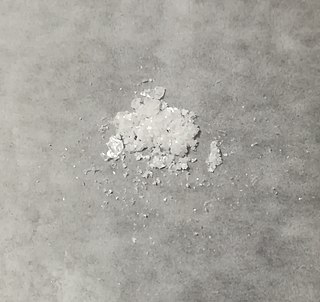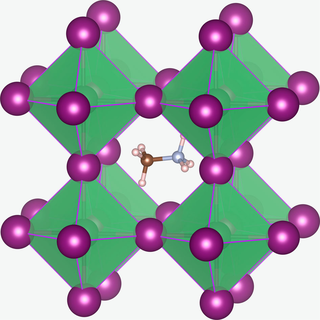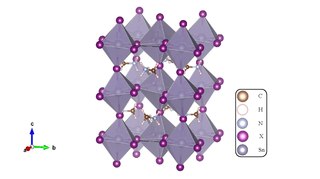
A perovskite is any material with a crystal structure following the formula ABX3, which was first discovered as the mineral called perovskite, which consists of calcium titanium oxide (CaTiO3). The mineral was first discovered in the Ural mountains of Russia by Gustav Rose in 1839 and named after Russian mineralogist L. A. Perovski (1792–1856). 'A' and 'B' are two positively charged ions (i.e. cations), often of very different sizes, and X is a negatively charged ion (an anion, frequently oxide) that bonds to both cations. The 'A' atoms are generally larger than the 'B' atoms. The ideal cubic structure has the B cation in 6-fold coordination, surrounded by an octahedron of anions, and the A cation in 12-fold cuboctahedral coordination. Additional perovskite forms may exist where either/both the A and B sites have a configuration of A1x-1A2x and/or B1y-1B2y and the X may deviate from the ideal coordination configuration as ions within the A and B sites undergo changes in their oxidation states.

Lead(II) iodide is a chemical compound with the formula PbI
2. At room temperature, it is a bright yellow odorless crystalline solid, that becomes orange and red when heated. It was formerly called plumbous iodide.

Copper(I) iodide is the inorganic compound with the formula CuI. It is also known as cuprous iodide. It is useful in a variety of applications ranging from organic synthesis to cloud seeding.
The thallium halides include monohalides, where thallium has oxidation state +1, trihalides in which thallium generally has oxidation state +3, and some intermediate halides containing thallium with mixed +1 and +3 oxidation states. These materials find use in specialized optical settings, such as focusing elements in research spectrophotometers. Compared to the more common zinc selenide-based optics, materials such as thallium bromoiodide enable transmission at longer wavelengths. In the infrared, this allows for measurements as low as 350 cm−1 (28 μm), whereas zinc selenide is opaque by 21.5 μm, and ZnSe optics are generally only usable to 650 cm−1 (15 μm).

Methylammonium chloride in an organic halide with a formula of CH3NH3Cl. It is an ammonium salt composed of methylamine and hydrogen chloride. One potential application for the methylammonium halides is in the production of perovskite solar cells. The methyl group and other hydrogen atoms are bonded covalently to the nitrogen, with the chloride bonded ionically.

Ruddlesden-Popper (RP) phases are a type of perovskite structure that consists of two-dimensional perovskite-like slabs interleaved with cations. The general formula of an RP phase is An+1BnX3n+1, where A and B are cations, X is an anion, and n is the number of octahedral layers in the perovskite-like stack. Generally, it has a phase structure that results from the intergrowth of perovskite-type and NaCl-type structures.

A perovskite solar cell (PSC) is a type of solar cell that includes a perovskite-structured compound, most commonly a hybrid organic–inorganic lead or tin halide-based material as the light-harvesting active layer. Perovskite materials, such as methylammonium lead halides and all-inorganic cesium lead halide, are cheap to produce and simple to manufacture.

Methylammonium bromide in an organic halide with a formula of CH3NH3Br. It is the salt of methylammonium and bromide. It is a colorless, water-soluble solid.
Methylammonium iodide in an organic halide with a formula of CH3NH3I. It is an ammonium salt composed of methylamine and hydrogen iodide. The primary application for methylammonium iodide, sometimes in combination with other methylammonium halides, is as a component of perovskite (structure) crystalline solar cells.

Methylammonium lead halides (MALHs) are solid compounds with perovskite structure and a chemical formula of [CH3NH3]+Pb2+(X−)3, where X = Cl, Br or I. They have potential applications in solar cells, lasers, light-emitting diodes, photodetectors, radiation detectors, scintillator, magneto-optical data storage and hydrogen production.
A tin-based perovskite solar cell is a special type of perovskite solar cell, where the lead is substituted by tin. It has a tin-based perovskite structure (ASnX3), where 'A' is a 1+ cation and 'X' is a monovalent halogen anion. The methylammonium tin triiodide (CH3NH3SnI3) has a band gap of 1.2–1.3 eV, while formamidinium tin triiodide has a band gap of 1.4 eV.

Perovskite nanocrystals are a class of semiconductor nanocrystals, which exhibit unique characteristics that separate them from traditional quantum dots. Perovskite nanocrystals have an ABX3 composition where A = cesium, methylammonium (MA), or formamidinium (FA); B = lead or tin; and X = chloride, bromide, or iodide.
Mixed-anion compounds, heteroanionic materials or mixed-anion materials are chemical compounds containing cations and more than one kind of anion. The compounds contain a single phase, rather than just a mixture.

Methylammonium tin halides are solid compounds with perovskite structure and a chemical formula of CH3NH3SnX3, where X = I, Br or Cl. They are promising lead-free alternatives to lead perovskites as photoactive semiconductor materials. Tin-based perovskites have shown excellent mobility in transistors which gives them an opportunity to be explored more for solar cell applications.
Arsenide bromides or bromide arsenides are compounds containing anions composed of bromide (Br−) and arsenide (As3−). They can be considered as mixed anion compounds. They are in the category of pnictidehalides. Related compounds include the arsenide chlorides, arsenide iodides, phosphide bromides, and antimonide bromides.
Antimonide bromides or bromide antimonides are compounds containing anions composed of bromide (Br−) and antimonide (Sb3−). They can be considered as mixed anion compounds. They are in the category of pnictidehalides. Related compounds include the antimonide chlorides, antimonide iodides, arsenide chlorides, arsenide bromides, arsenide iodides, phosphide chlorides, phosphide bromides, and phosphide iodides. The bromoantimonates have antimony in positive oxidation states.
Arsenide chlorides or chloride arsenides are compounds containing anions composed of chloride (Cl−) and arsenide (As3−). They can be considered as mixed anion compounds. They are in the category of pnictidehalides. Related compounds include the arsenide bromides, arsenide iodides, phosphide chlorides, and antimonide chlorides.
Antimonide iodides or iodide antimonides are compounds containing anions composed of iodide (I−) and antimonide (Sb3−). They can be considered as mixed anion compounds. They are in the category of pnictide halides. Related compounds include the antimonide chlorides, antimonide bromides, phosphide iodides, and arsenide iodides.
Erbium compounds are compounds containing the element erbium (Er). These compounds are usually dominated by erbium in the +3 oxidation state, although the +2, +1 and 0 oxidation states have also been reported.
Protactinium compounds are compounds containing the element protactinium. These compounds usually have protactinium in the +5 oxidation state, although these compounds can also exist in the +2, +3 and +4 oxidation states.
![[CH3NH3]I powder CH3NH3I powder.jpg](http://upload.wikimedia.org/wikipedia/commons/thumb/2/2b/CH3NH3I_powder.jpg/170px-CH3NH3I_powder.jpg)









